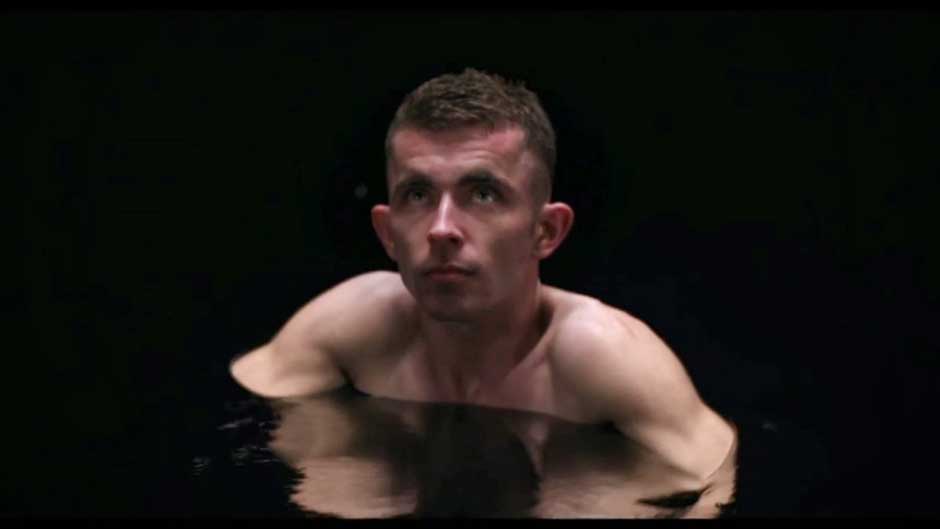Jonathan Glazer’s Under the Skin is a film with the courage of its silences and ellipses. Most easily categorized as a species of science fiction, it deftly evades verbal explanation and explicit continuity. It is in fact based on a well-received science fiction novel by Michel Faber, concerning an alien being who has been sent to northern Scotland in the guise of a woman to pick up and trap men for consumption by other aliens. But Glazer seems to have ended by omitting most of the narrative content of his source, taking away backstory and motivation bit by bit until what is left is deliberately fragmentary and open-ended.
A skeletal version of the narrative of alien entrapment survives as a nearly abstract road movie, as Scarlett Johansson glides through Glasgow and environs engaging random men in desultory conversation before leading them to a particularly creepy form of disembodiment. Dialogue is sparse and uncommunicative; episodes are peremptorily curtailed; and crucial relationships, like that of Johansson to the fellow extraterrestrials who track her progress, are left opaque. It’s as if various different films were superimposed, with the gaps between them occasionally showing. The spectator is almost invited to fill in the holes according to whatever personal hidden storyline the film provokes into being. I doubt that I could provide a complete synopsis without incorporating linking moments that are not actually there to be seen.
The film’s real connective tissue is Mica Levi’s penetrating and sometimes tormented score, which makes the question of narrative continuity to some extent irrelevant. Glazer is known for his music videos, and a case could be made that the whole film underscores the music as much as the music does the film. The otherness to which the film is given over finds in the music a language that manages to stand in for the expressive human speech otherwise so notably absent.
From the outset, the tone Under the Skin establishes is rather solemn and ritualistic. A pinpoint of light expands into a vision of planetary bodies moving in mysterious conjunctions. From interstellar vastness we move to a human eye that fills the screen like Kim Novak’s in the main titles of Vertigo. On the soundtrack, elements of human speech float around each other as if coalescing into a newly acquired language. Then abruptly we are on Earth, where a stream runs alongside a highway in the dark and we are shown inexplicable things—a woman’s body retrieved by a helmeted motorcyclist (out of Cocteau?) along the road, the same body reborn as a black-wigged Scarlett Johansson. (With the black wig and a fake fur minicoat, Johansson unavoidably evokes Anna Karina in Vivre sa vie.) We have landed in a domain of exquisitely crafted unease and uncertainty that will be sustained without relief through the film’s 108 minutes. In the small screening room where I saw it there were scattered groans of boredom and some involuntary giggles, and then, at the movie’s moment of final revelation—a kick in the eye that manages for an instant to turn visible reality inside out—a bewildered voice from the dark: “What is that?”
The brief cosmic prelude evokes for an instant the old outer space vistas of countless now-antiquated science fiction movies like, say, Roger Corman’s 1959 War of the Satellites, a cheapie whose bargain-basement visions of exploding rockets and shimmering barriers in space are light years from the technology that Glazer is able to call on. As it turns out, once it has gotten past that introductory passage, Under the Skin is a science fiction film almost—save for a few brief crucial scenes—without special effects. Most of it was shot with hidden cameras on highways and city streets, human places that seem worn-out and dated but without any of the charm of nostalgia. We now inhabit to a large degree the science fiction future that Corman anticipated in such a rudimentary way, and the implicit special effect here is the act of looking at these towns and streets, gas stations and cafes and dance halls, and the people who live among them, through the eyes of a future that has already arrived.
The eyes are those of the woman-like alien, and her ride feels like a familiar story that goes on perpetuating itself, from era to era, in one form after another. It could be a serviceable device for a porn film, or a vampire film, or perhaps merely a film about a disconnected person interacting inconclusively with a succession of other disconnected persons. Deep underneath, some medieval tale of a wandering succubus continues to play out, only here we are given the story from the point of view of the succubus, a succubus moreover who seems scarcely to know what world she is on or why she is engaged in this mission. In a condition of wary puzzlement she looks at everything through the windshield.
Advertisement
It all seems filmed more or less under the sign of generic urban loneliness, and human behavior through her alien eyes is invariably awkward and almost unreadable. Many of the unwitting men she encounters were unaware they were being filmed, and their dialogue with her has a degree of aimless inexpressiveness that becomes part of the film’s fabric. The men, who for the most part might have been chosen for their lack of any striking personal characteristics or powerful screen presence, seem a nice enough lot, polite and helpful and a bit bewildered at being accosted in the middle of nowhere by a woman so out of keeping with her gritty surroundings. All these city scenes have a pervasive glumness that seems to be just barely warded off by its inhabitants through an everyday patience and a determination not to succumb, although these qualities can only be surmised in the most tentative attempts at expressing their wishes.
As counterpoint we catch curious curtailed glimpses of the fate of these men once they pass through the doorway of a derelict building into which she leads them: a slow striptease as the woman moves backward, the man advancing toward her as if pulled on a string. This is a tease indeed, as no contact is ever permitted before the men sink into the floor—or whatever that viscid surface is—and disappear without protest, to be emptied out, leaving only a drifting shape like a popped balloon floating down through the liquid element. The rhythm of the film becomes very much an alternation between sleeping and waking, between dreams of submersion and dissolution and wide-awake surveillance of actual strangers in an actual city. One of these anonymous strangers is a man whose extreme disfigurement is real, and this provokes a crisis within the film as it does within the protagonist. Our own compassion is challenged as hers is, and the fictional frame of the film for a moment gives way to the direct contemplation of human suffering. She spares him and sends him running naked but alive.
At any given moment we might be watching a fantastic tale dressed up in documentary trappings or a mass of documentary footage held together by the wisp of a fantasy. The fantastic element resides essentially in the person of Scarlett Johansson, who while often naked is at the same time entirely concealed: a paradox that unravels itself in the most literal way in the film’s final images. This watcher, who is seen only as the character she impersonates, remains apparently, in her moments of solitariness, entirely without feeling. She is an archetype, but an archetype arrived at by a mimetic creature able to construct herself into a lure—at least until, having perhaps outstayed her visit, she evidently becomes contaminated by empathy. A series of disjoined episodes—a drowning at an inlet in which one person dies trying to save another, the encounter with the disfigured man, the experience of being helped to her feet by strangers when she trips on the street, the evidently brief experience of sexual tenderness—disturb her balance and functioning and she attempts to escape from her assigned task.
The danger, aesthetically, is of an all too legible allegory, even without verbal cues. But a powerful sense of physical presence saves Under the Skin from any obvious message. Scarlett Johansson quite uncannily enacts the dissolving of a personality that was never real to begin with and its gradual replacement by something emergent and unformed. She moves forward with a kind of awed panic in which every place and object she meets seems keyed to an intense pitch. The beauty of these scenes is how they succeed in making any ordinary thing strange. The interior, for instance, of the home where she stays for a time with her lover is so exactly and concisely rendered that the damp chill of the room temperature—as a cup of tea is passed to her—is almost palpable.
She advances into ever more northerly regions, losing herself on empty roads and in thick mist before entering the forest mazes where she will finally become herself the victim of another, earthly predator. The loneliness she has inherited by mixing with humans is rendered by climatic textures, as in a single shot of great trees waving in a storm. If the purpose was to explore how many different ways there are of being alien, the forms of landscape—violent seacoast, concealing fog, somber forest—become more alien than anything else. The film becomes truly science fiction when it exposes the oddity of such a planet existing at all.
Advertisement
Under the Skin has one final and necessary lurch to complete its trajectory, a lurch that looks like an accidental rip in the image, as if the film had broken apart, but which turns out to be the emerging shape that had been concealed by what was visible: the actual being who wore the appearance of Scarlett Johansson as a disguise. This shedding of identity leads fittingly enough into the image of a funeral pyre. In place of any sort of answer we are left with a quite sublime juxtaposition of fire and snow. The black smoke rising toward the falling flakes looks a wedding ritual conducted by non-human forces.
Under the Skin is now in general release.





